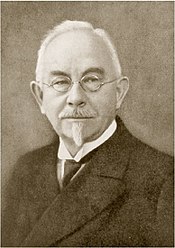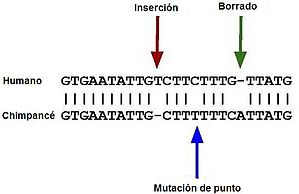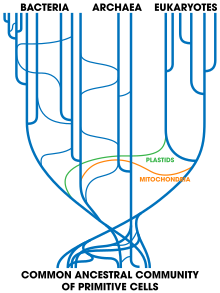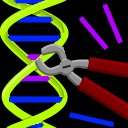Gene
A gene is a unit of information at a deoxyribonucleic acid (DNA) locus that encodes a gene product, either protein or RNA. It is the molecular unit of genetic inheritance, since it stores genetic information and allows it to be transmitted to offspring. Genes are found on chromosomes, and each one occupies a certain position on them called a locus. The set of genes of a species is called a genome.
For each locus, there may be several possible alleles (that is, they may have different shapes with different consequences). When genes are in close proximity, they are less likely to separate in crossing over, that is, they do not segregate independently but en bloc. Linkage groups refer to the set of genes located at nearby loci that are transmitted together.
Molecularly, the gene is a sequence of contiguous nucleotides in the DNA molecule (or RNA in the case of some viruses) that contains the necessary information for the synthesis of a macromolecule with a specific cellular function, that is, linked to development or performance of a physiological function. Generally, these products are proteins, after passing through messenger RNA (mRNA), but also non-coding RNA, such as ribosomal RNA (rRNA), transfer RNA (tRNA) and many others with regulatory functions or whose function is gradually being understood.
History
The concept of gene has changed over time, as the science that studies it, genetics, has advanced:
- Gregor Mendel in his experiments proposed the original idea of the gene, even though he did not call them genes, but rather factorsand they would come to be responsible for transmitting the characters from one generation to the next (what we now call genotype). The Mendelian gene is a unit of function, structure, transmission, mutation and evolution that is distributed and linearly ordered in chromosomes.
- The word gen was coined in 1909 by the Danish botanist Wilhelm Johannsen from a Greek word meaning "generate", referring to the physical and functional unity of the biological heritage.
- By 1950, the concept of gene was imposed as the DNA chain leading a protein synthesis. This is a concept that provides a molecular or structural nature to the gene. The gene encodes proteins and must have a structure defined by the linear order of its triplets or codones.
- Later comes the concept of gene as what is currently called a cistron: the DNA chain capable of directing the synthesis of an RNA that encodes for a polypeptide (central dose of molecular biology). This concept arises by checking that most proteins are made up of more than one polypeptide chain and that each of them is encoded by a different gene.
- It is now known that some genes encode more than one polypeptide and that a protein can be encoded by the set of different genes. The existence of overlapping genes and alternative processing remove the hypothesis of a gene → a polypeptide. Rather the reverse relationship should be proposed, a polypeptide → a gene. In addition, there are some genes that do not encode proteins but RNAs with their own function (RNAs and RNAs, for example) and which do not translate, so it is not necessary to translate for a gene to have a particular function. The gene is therefore the minimum unit of genetic function, which can be inherited.
Modern concept of the gene
From Mendel's original theory of the determination of specific physical characters (eg, flower color) by discrete hereditary particles, the concept of a gene has gradually evolved towards that of a functional unit. This was first announced in 1945 by geneticist George Beadle (1903-1989), who proposed that each gene was specific: the "one gene, one protein" hypothesis. It was later modified when it was understood that genes could also determine non-enzymatic proteins and also individual polypeptide chains (protein subunits) and the various types of RNA involved in protein synthesis. The development of new techniques in the 1960s and 1980s, especially DNA sequencing and gene cloning, enabled molecular geneticists to unravel the precise structure of genes down to the base level.
Such techniques provide a lot of information about how genes are turned on and off and about other aspects of their expression.
Types of genes
A gene is a sequence or segment of DNA necessary for the synthesis of functional RNA, such as transfer RNA or ribosomal RNA. However, these two types of RNA do not code for protein, which is done by messenger RNA. To do this, the transcription generates an RNA molecule that will later undergo translation in the ribosomes, a process by which a protein is generated. Many genes are made up of coding regions (exons) interrupted by non-coding regions (introns) that are eliminated in RNA processing (splicing). In prokaryotic cells this does not occur because prokaryotic genes lack introns. The sequence of bases present in the RNA determines the amino acid sequence of the protein through the genetic code.
Other genes are not translated into protein, but carry out their function in the form of RNA. Among these, we find transfer RNA genes, ribosomal RNA, ribozymes, and other small RNAs with diverse functions.
Some genes have undergone mutation processes or other reorganization phenomena and have ceased to be functional, but they persist in the genomes of living beings. When they no longer have a function, they are called pseudogenes, which constitute an evolutionary resource for the species, since they are quasifunctional regions of DNA that can accept mutations (and generate new functions) without prejudice to the functions that already exist. they develop in the organism, and can be very similar to other genes in the same organism that are functional.
Structure and function
Molecular evolution
Mutation
DNA replication is done with extreme precision, however errors, called mutations, can occur. The error rate in eukaryotic cells can be as low as 10–8 mutations per nucleotide replicate, while in some RNA viruses the rate can be as high as 10−3. Thus, in each generation each human genome accumulates approximately 1–2 new mutations. Small mutations They can originate during the process of DNA replication, which are usually repaired by a process known as DNA repair, although if this process does not identify or correct the mutation, damage would occur that would lead to the appearance of genetic mutations. This failure is nothing more than the substitution of a substituted nitrogenous base for another, or else something much more dangerous, a shift of the reading frame in which one base is inserted or deleted (or two, the change would affect less if the deletion occurs in three bases, since the reading of the DNA is done by triplets). Any of these mutations can modify the function of the gene, giving rise to a nonsense mutation (changes of a codon for another that is translated by a different amino acid, which modifies the functionality of the translated protein). missense, in which the resulting codon translates into the same amino acid (the genetic code is degenerate, which means that several combinations of triplets translate into the same amino acid): this would be a mutation with meaning. Larger mutations can be caused by errors in recombination, in synapses, or during the process of meiosis or mitosis during chromosome sharing, causing chromosome mutations and aneuploidies, respectively. These failures include gene duplication (doubling of a cell's genetic makeup by containing an extra copy of its host chromosome), or the deletion, rearrangement, and inversion of large sections of a chromosome. Also the DNA repair mechanism can introduce errors when trying to repair physical damage to the DNA molecule.
The existence of multiple alleles of a gene, concurrent in the same population, is called polymorphism. Most of the different alleles function in an equivalent way; however, some may have different biological characters. The most common allele of a gene is called the wild type, and rare (infrequent) alleles are called mutants. Variation in relative frequencies of different alleles in a population is a consequence of natural selection and genetic drift (measures of an allele's adaptive success and statistical effect, respectively). The wild-type allele is not definitely the ancestor of the alleles. less common nor is it necessarily true that they are more adapted.
Most mutations that occur in genes tend to be neutral because they do not affect the phenotype of the organism. Even if a mutation is not neutral it can lead to a functionally identical protein, since the substitution can be with an equivalent or non-detrimental amino acid within the internal structure of the protein it encodes. However, many mutations are harmful when not clearly lethal, being discarded by natural selection. Genetic disorders result from deleterious mutations, sometimes due to a spontaneous mutation in the affected individual early in development, or inherited from one or both parents where another copy of the gene takes over the function that the child inherits. A few benefit the organism, improving fitness, and matter a great deal because they thus direct adaptive evolution.
Sequence Homology
Genes with a more recent common ancestor, that is, shared evolutionary ancestry, are known as homologs. These genes appear, either by gene duplication, within the genome of an organism, and are called paralogous genes, or result from Gene divergences after a speciation event are called orthologous genes, and often perform the same or similar function in related organisms. It is often assumed that the functions of orthologous genes are more similar than those of paralogous genes, although the differences are very small.
The relationship between genes can be measured by comparing their DNA sequence alignment. The degree of sequence similarity between homologous genes is called conserved sequence. Most changes do not affect gene function and therefore genes accumulate mutations over time, due to neutralistic molecular evolution. Furthermore, any selection on a gene will cause its sequence to diverge at a different rate. Genes under stabilizing selection are constrained and therefore change more slowly, whereas genes under directional selection change sequence more rapidly. Sequence differences between genes can be used for phylogenetic analyzes to study how those genes evolved and how the organisms they came from are related.
Origin of new genes
The most common source of genes in eukaryotic cells is chromosome duplication, which creates variation in the copy number of a gene that already exists in the genome. The resulting genes (paralogs) may then diverge in their sequence and also in its function. Groups of genes formed in this way are called a gene family. Genetic duplications and losses within a family are common and represent a major source of genetic diversity and evolutionary biodiversity. Sometimes gene duplication will result in a non-functional copy of a gene, or a copy that should work., but due to mutations, he experiences loss of functions; such genes are called pseudogenes.
Genomes
The genome is the total genetic material of an organism and includes genes as well as non-coding sequences.
Number of genes in some biological forms
Genome size and the number of coding genes vary greatly among life forms. The smallest genomes occur in viruses, which may have only two coding genes to encode their proteins, and viroids, which act as a single non-coding RNA gene. Plants, on the other hand, can have very large genomes., with rice containing >46,000 protein-coding genes. The total number of protein-coding genes (Earth's proteome) is estimated to be 5 million sequences.
Although the number of DNA base pairs in the human genome has been known since the 1960s, the estimate of the number of genes has changed over the years for reasons such as changes in the definition of what a gene is, and improvements in the methods used to detect the genes. Initial theoretical predictions of the number of human genes would reach two million. Initial experiments indicated that there were between 50,000-100,000 gene transcripts (Expressed Marker Sequence). Later, sequencing done in the Human Genome Project indicated that many of the transcripts were alternative variants of the same gene, and the total number of protein-coding genes dropped to –20,000 with 13 of the coding genes in the mitochondrial genome. Of the human genome only 1-2% consist of genes protein-coding, with the others being non-coding DNA such as introns, retrotransposons, and non-coding RNA.
| Biological form | N.o. genes | base pairs |
|---|---|---|
| Plants | 50000 | ¢Ü11 |
| Human Rights | 20,000-25,000 | 3 × 109 |
| Moscas | 12000 | 1.6 × 108 |
| Hong | 6000 | 1.3 × 107 |
| Bacteria | 500-6000 | 5 × 105 - 107 |
| Mycoplasma genitalium | 500 | 580.000 |
| DNA virus | 10-300 | 5000-800 000 |
| Virus ARN | 1-25 | 1000 |
| Plásmidos | 30-100 | 3000-900 000 |
| Transposions | 1-10 | 2000-10 000 |
| Viroids | 0-1 | - 500 |
| Prisons | 0 | 0 |
Gene changes
Diploid organisms have two sets of homologous chromosomes, each from one of the parents, whose gametes (created by meiosis) fused into a cell known as a zygote, during sexual reproduction. For example, the gametes (ovum and sperm) of the human being only contain 23 simple chromosomes, (they are haploid) but once the cell division of the zygote created by fertilization is finished in four cells, each cell of the new baby will have 23 pairs of chromosomes, that is, 46 chromosomes, one of the pairs coming from the mother and another from the father.
Some diseases, such as sickle cell anemia, can be caused by a change in a single gene. Genes can appear in different versions, with small variations in their sequence: this is what is called alleles. Alleles can be dominant or recessive. When a single copy of the allele causes the trait or phenotype to be manifested, the allele is dominant. When two copies of the allele are required for its effect to manifest, the allele is recessive.
Regulation
A gene is the set of a determined sequence of nucleotides on one side of the "ladder" of the referenced chromosome. The sequence can go on to form proteins, or they will be inhibited, depending on the program assigned to the cell that contributes the chromosomes.
Horizontal gene transfer
Horizontal gene transfer refers to the movement of genes between living things that is not through vertical transmission from (fathers/mothers to children). Horizontal gene transfer occurs most commonly in unicellular organisms, but it also occurs in multicellular organisms. This transfer has turned out to be an important factor in the evolution of living things. Although it is surprising to speak of a transfer of genes other than through offspring, evidence accumulating in the 1940s that prokaryotes could move their genetic material around by means of molecules known as plasmids. These molecules can carry genes associated with fertility, phenotype and metabolism, they can even incorporate genes that help bacteria become resistant to antibiotics or virulent genes that favor the pathogenesis of bacteria. Plasmids can not only be transmitted between prokaryotic strains but also between different species.
However, plasmids were not the only gene vectors, since it was later discovered that transposons, DNA sequences capable of moving to different parts of the genome, could be transferred between organisms that live in symbiosis, such as: lichens, invertebrates such as insects or crustaceans, fungi, plants, etc. In humans, cases of horizontal gene transfer with parasitic nematodes by means of transposons have been documented. It also became evident that viral agents (viruses, viroids and satellite viruses) during their contagion and infection they could incorporate genes from one host and take it to another host, including other species. Viruses can be considered the single most predominant means of horizontal gene transfer between living beings even though they are infective, in addition viruses develop particles proteins (virions) that allow it easy mobility between its hosts. Also, more recently, it has been identified that viruses can receive additional genes from satellite viruses that depend on them for coinfection. In turn, plasmids and transposons can receive additional genes from integrons, which are mobile gene cassettes found in prokaryotes. This demonstrates that gene movement exists not only in cellular organisms but also between vector particles. All of these molecules or particles have been commonly referred to as the mobilome, or mobile genetic elements.
Other mechanisms of horizontal gene transfer include recombination, gene loss, duplication, and gene creation. Horizontal gene transfer turns out to be a limitation for evolutionists since if two species have exchanged genes along Throughout evolution they may appear to be the same in a phylogenetic analysis without having to share a common ancestor, because that gene is the same even though many other genes are not similar. For this reason it is sometimes ideal to use other information to infer large phylogenies such as the presence or absence of genes, or more commonly to include a large range of genes for phylogenetic analysis. Proteome analyzes may also be useful for determining phylogenetic relationships between organisms that undergo horizontal gene transfer or have high rates of genetic mutation.
Genetic engineering
In genetic engineering, the genome of an organism is modified using methods of biotechnology. Since the 1970s, techniques have been developed that specifically add and edit an organism. More recently, genome engineering has developed some techniques that use enzymes nucleases to create bleached DNA repairs on a chromosome, or to disrupt or edit a gene when the break is repaired. The term cognate is synthetic biology which is sometimes used to refer to the extensive engineering of an organism.
Genetic engineering is now a routine research tool using a model organism. For example, adding genes to bacteria is easy while lineages of knockout mice with disrupted gene function are used to investigate the function of that gene. Many genes have been modified for applications in agriculture, medicine, and biotechnology. industrial.
For multicellular organisms, typically an embryo is engineered, which grows into an adult genetically modified organism. However, the genomes in cells of an adult organism can be edited by using gene therapy techniques to try to cure diseases with genetic causes.
Additional bibliography
- Nicolas Jouve de la Barreda. Exploring genes. From big-bang to new biology. Editions Encounter. ISBN 978-84-7490-901-2.
Contenido relacionado
Anthaenantiopsis
Monocarpy
Ustilaginomycetes










